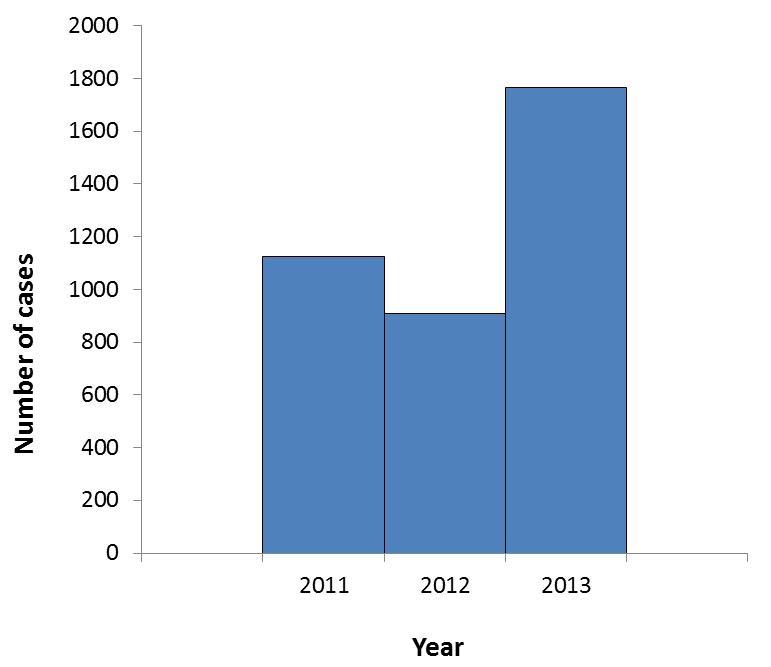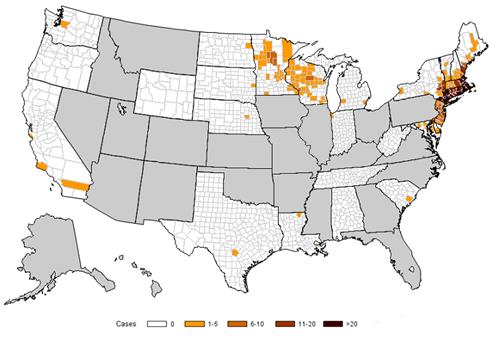Babesiosis epidemiology and demographics: Difference between revisions
| Line 6: | Line 6: | ||
Babesiosis is a [[Vector (biology)|vector]]-borne illness usually transmitted by [[tick]]s, often referred to as "The Malaria of The North East." (''Babesia microti'' uses the same tick vector, ''[[Ixodes scapularis]]'', as [[Lyme disease]] and frequently occurs in conjunction with it.) In ''babesia''-endemic areas, the organism can also be transmitted by [[blood transfusion]]. | Babesiosis is a [[Vector (biology)|vector]]-borne illness usually transmitted by [[tick]]s, often referred to as "The Malaria of The North East." (''Babesia microti'' uses the same tick vector, ''[[Ixodes scapularis]]'', as [[Lyme disease]] and frequently occurs in conjunction with it.) In ''babesia''-endemic areas, the organism can also be transmitted by [[blood transfusion]]. | ||
Key endemic areas within the United States include the northeastern coastal region, in the specific states and regions as listed: | |||
*New York - Eastern Long-Island and its barrier island, Fire Island. As well as Shelter Island. | *New York - Eastern Long-Island and its barrier island, Fire Island. As well as Shelter Island. | ||
Revision as of 17:06, 8 December 2015
Editor-In-Chief: C. Michael Gibson, M.S., M.D. [1]
|
Babesiosis Microchapters |
|
Diagnosis |
|---|
|
Treatment |
|
Case Studies |
|
Babesiosis epidemiology and demographics On the Web |
|
American Roentgen Ray Society Images of Babesiosis epidemiology and demographics |
|
Risk calculators and risk factors for Babesiosis epidemiology and demographics |
Epidemiology and Demographics
Babesiosis is a vector-borne illness usually transmitted by ticks, often referred to as "The Malaria of The North East." (Babesia microti uses the same tick vector, Ixodes scapularis, as Lyme disease and frequently occurs in conjunction with it.) In babesia-endemic areas, the organism can also be transmitted by blood transfusion.
Key endemic areas within the United States include the northeastern coastal region, in the specific states and regions as listed:
- New York - Eastern Long-Island and its barrier island, Fire Island. As well as Shelter Island.
- Massachusetts- Cape Cod, as well as Islands off the Massachusetts coast such as Nantucket Island and Martha's Vineyard.
- Rhode Island- Block Island.
Prevalence of infection is also codependent on particular endemic areas. Analysis of patient blood smears for an antibody specific to B microti on the United State's Northeastern coast suggests that rates of infection fluctuate seasonally and geographically. Amongst the Cape Cod (Massachusetts)patient population 3.7% reported Babesiosis infection. Infection rates were reported at a slighter higher percentage in Shelter Island (New York),reaching percentages of 4.4% during June and increasing to 6.9% by October. These instances account for both the predominant vector-host transmission as well as the rarer instances of blood transfusion transmission.
Other United States regions to have reported at least a single instance of infection include the Western states of California and Washington; Central states of Wisconsin, Minnesota, Nebraska, North Dakota, South Dakota , Indiana, Michigan, and Missouri; Northeastern states of Connecticut , New Jersey, New Hampshire, Delaware, Maine, Vermont and Maryland; and in the Southern states of Virginia, South Carolina, Louisiana, Texas, and Georgia. However reported cases of Babesiosis are less prevalent in these aforementioned states than those referred to previously on the Northeastern coast.
Geographically, increased populations of deer, either by means of restocking or states environmental and hunting sanctions, has seemingly contributed to the heightened prevalence of Babesiosis in the United States. Other contributing factors to the heightened infection rate within these areas may be attributed to an increasing trend in outdoor recreational activity within the aforementioned endemic areas.
In 2013, 27 states (all of which are previously listed excluding: Alabama, Oregon, Tennessee, West Virginia, and Wyoming where screening results reported zero occurrences of the disease) conducted a patient population survey for reported Babesiosis. The findings resulted in a total 1,762 reported cases. Comparison of Babesiosis infection rates over the years presents difficulty as it was only declared a nationally notifiable condition by the CDC in January 2011. Yet an analysis of the data collected by the CDC between the years of 2011 and 2013 reveals a heightened increase of nearly 500 more reported cases in 2013. Furthermore the total prevalence of the disease is practically unattainable as many of the North American cases are non-reported and asymptomatic.

Infected populations have also been recorded in regards to sex and age. Of the total, 1,762 cases reported to the CDC in 2013, findings indicate a median age of 62 years, as well as a distribution of infection between males and females at 65% and 32% respectively.
Severity of Babesiosis varies as infection with Babesia parasites can be asymptomatic or cause a mild non-specific illness, although it may also result in severe disease. However most severe cases occur in the very young, very old, or persons with underlying medical conditions (such as immunodeficiency) and those without a spleen, they can occur in normal individuals.
In Europe, babesia transmission is primarily the fault of Ixodes ricinus (a European species of ticks). Due to the wide distribution of the species through the European continent, reported cases are not isolated to specific regions. Unlike more common cases of the disease in the United States, babesiosis is a rather rare occurrence in Europe. The disease has also proven a higher morbidity rate. Of the 39 European cases published, all were reported as clinically severe and required immediate action. However, of the reported babesiosis cases reported thus far, the majority have been identified as previously immunocompromised or had undergone a splenectomy.
References
Available at: http://www.cdc.gov/parasites/babesiosis/epi.html. Accessed December 8, 2015.
Available at: http://www.cdc.gov/parasites/babesiosis/data-statistics/index.html. Accessed December 8, 2015.
Available at: http://ecdc.europa.eu/en/healthtopics/babesiosis/Pages/Factsheet_health_professionals.aspx. Accessed December 8, 2015.
